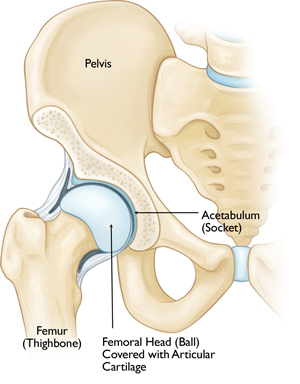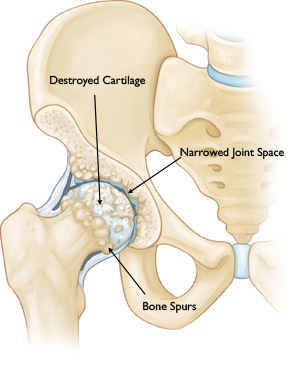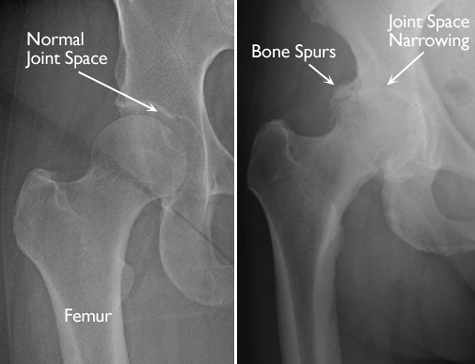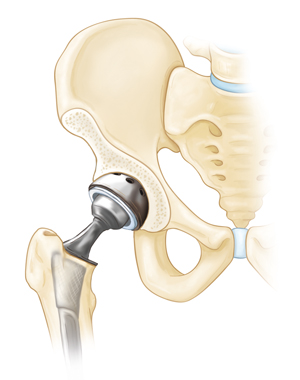
Osteoarthritis of the Hip
Information on hip osteoarthritis is also available in Spanish: Osteoartritis de cadera.
Sometimes called "wear-and-tear" arthritis, osteoarthritis is a common condition that many people develop during middle age or older. In 2011, more than 28 million people in the United States were estimated to have osteoarthritis. It can occur in any joint in the body, but most often develops in weight-bearing joints, such as the hip.
Osteoarthritis of the hip causes pain and stiffness. It can make it hard to do everyday activities like bending over to tie a shoe, rising from a chair, or taking a short walk.
Because osteoarthritis gradually worsens over time, the sooner you start treatment, the more likely it is that you can lessen its impact on your life. Although there is no cure for osteoarthritis, there are many treatment options to help you manage pain and stay active.
AnatomyThe hip is one of the body's largest joints. It is a "ball-and-socket" joint. The socket is formed by the acetabulum, which is part of the large pelvis bone. The ball is the femoral head, which is the upper end of the femur (thighbone).
The bone surfaces of the ball and socket are covered with articular cartilage, a smooth, slippery substance that protects and cushions the bones and enables them to move easily.
The surface of the joint is covered by a thin lining called the synovium. In a healthy hip, the synovium produces a small amount of fluid that lubricates the cartilage and aids in movement.
 The anatomy of the hip.
Top of page
Description
The anatomy of the hip.
Top of page
Description
Osteoarthritis is a degenerative type of arthritis that occurs most often in people 50 years of age and older, though it may occur in younger people, too.
In osteoarthritis, the cartilage in the hip joint gradually wears away over time. As the cartilage wears away, it becomes frayed and rough, and the protective joint space between the bones decreases. This can result in bone rubbing on bone. To make up for the lost cartilage, the damaged bones may start to grow outward and form bone spurs (osteophytes).
Osteoarthritis develops slowly and the pain it causes worsens over time.
 A hip damaged by osteoarthritis.
A hip damaged by osteoarthritis.
Animation courtesy Visual Health Solutions, Inc.
Top of page CauseOsteoarthritis has no single specific cause, but there are certain factors that may make you more likely to develop the disease, including:
- Increasing age
- Family history of osteoarthritis
- Previous injury to the hip joint
- Obesity
- Improper formation of the hip joint at birth, a condition known as developmental dysplasia of the hip
Even if you do not have any of the risk factors listed above, you can still develop osteoarthritis.
Top of page SymptomsThe most common symptom of hip osteoarthritis is pain around the hip joint. Usually, the pain develops slowly and worsens over time, although sudden onset is also possible. Pain and stiffness may be worse in the morning, or after sitting or resting for a while. Over time, painful symptoms may occur more frequently, including during rest or at night. Additional symptoms may include:
- Pain in your groin or thigh that radiates to your buttocks or your knee
- Pain that flares up with vigorous activity
- Stiffness in the hip joint that makes it difficult to walk or bend
- "Locking" or "sticking" of the joint, and a grinding noise (crepitus) during movement caused by loose fragments of cartilage and other tissue interfering with the smooth motion of the hip
- Decreased range of motion in the hip that affects the ability to walk and may cause a limp
- Increased joint pain with rainy weather
During your appointment, your doctor will talk with you about your symptoms and medical history, conduct a physical examination, and possibly order diagnostic tests, such as x-rays.
Physical Examination
During the physical examination, your doctor will look for:
- Tenderness about the hip
- Range of passive (assisted) and active (self-directed) motion
- Crepitus (a grating sensation inside the joint) with movement
- Pain when pressure is placed on the hip
- Problems with your gait (the way you walk)
- Any signs of injury to the muscles, tendons, and ligaments surrounding the hip
Imaging Tests
X-rays. These imaging tests create detailed pictures of dense structures, like bones. X-rays of an arthritic hip may show a narrowing of the joint space, changes in the bone, and the formation of bone spurs (osteophytes).
 (Left) In this x-ray of a normal hip, the space between the ball and socket indicates healthy cartilage. (Right) This x-ray of an arthritic hip shows severe loss of joint space and bone spurs.
(Left) In this x-ray of a normal hip, the space between the ball and socket indicates healthy cartilage. (Right) This x-ray of an arthritic hip shows severe loss of joint space and bone spurs.
Other imaging tests. Occasionally, a magnetic resonance imaging (MRI) scan, a computed tomography (CT) scan, or a bone scan may be needed to better determine the condition of the bone and soft tissues of your hip.
Top of page TreatmentAlthough there is no cure for osteoarthritis, there are a number of treatment options that will help relieve pain and improve mobility.
Nonsurgical Treatment
As with other arthritic conditions, early treatment of osteoarthritis of the hip is nonsurgical. Your doctor may recommend a range of treatment options.
Lifestyle modifications. Some changes in your daily life can protect your hip joint and slow the progress of osteoarthritis.
- Minimizing activities that aggravate the condition, such as climbing stairs.
- Switching from high-impact activities (like jogging or tennis) to lower impact activities (like swimming or cycling) will put less stress on your hip.
- Losing weight can reduce stress on the hip joint, resulting in less pain and increased function.
Physical therapy. Specific exercises can help increase range of motion and flexibility, as well as strengthen the muscles in your hip and leg. Your doctor or physical therapist can help develop an individualized exercise program that meets your needs and lifestyle.
Assistive devices. Using walking supports like a cane, crutches, or a walker can improve mobility and independence. Using assistive aids like a long-handled reacher to pick up low-lying things will help you avoid movements that may cause pain.
Medications. If your pain affects your daily routine, or is not relieved by other nonsurgical methods, your doctor may add medication to your treatment plan.
- Acetaminophen is an over-the-counter pain reliever that can be effective in reducing mild arthritis pain. Like all medications, however, over-the-counter pain relievers can cause side effects and interact with other medications you are taking. Be sure to discuss potential side effects with your doctor.
- Nonsteroidal anti-inflammatory drugs (NSAIDs) may relieve pain and reduce inflammation. Over-the-counter NSAIDs include naproxen and ibuprofen. Other NSAIDs are available by prescription.
- Corticosteroids (also known as cortisone) are powerful anti-inflammatory agents that can be taken by mouth or injected into the painful joint.
Surgical Treatment
Your doctor may recommend surgery if your pain from arthritis causes disability and is not relieved with nonsurgical treatment.
Osteotomy. Either the head of the thighbone or the socket is cut and realigned to take pressure off of the hip joint. This procedure is used only rarely to treat osteoarthritis of the hip.
Hip resurfacing. In this hip replacement procedure, the damaged bone and cartilage in the acetabulum (hip socket) is removed and replaced with a metal shell. The head of the femur, however, is not removed, but instead capped with a smooth metal covering.
Total hip replacement. Your doctor will remove both the damaged acetabulum and femoral head, and then position new metal, plastic or ceramic joint surfaces to restore the function of your hip.
 In total hip replacement, both the head of the femur and the socket are replaced with an artificial device.
In total hip replacement, both the head of the femur and the socket are replaced with an artificial device.
Animation courtesy Visual Health Solutions, Inc.
Complications. Although complications are possible with any surgery, your doctor will take steps to minimize the risks. The most common complications of surgery include:
- Infection
- Excessive bleeding
- Blood clots
- Hip dislocation
- Limb length inequality
- Damage to blood vessels or arteries
Your doctor will discuss possible complications with you before your surgery.
Top of page RecoveryAfter any type of surgery for osteoarthritis of the hip, there is a period of recovery. Recovery time and rehabilitation depends on the type of surgery performed.
Your doctor may recommend physical therapy to help you regain strength in your hip and to restore range of motion. After your procedure, you may need to use a cane, crutches, or a walker for a time.
In most cases, surgery relieves the pain of osteoarthritis and makes it possible to perform daily activities more easily.
Source: National Estimates: Osteoarthritis. Department of Research & Scientific Affairs, American Academy of Orthopaedic Surgeons. Rosemont, IL: AAOS; January 2013. Based on Lawrence RC, Felson DT, Helmick CG, et al. Estimates of the prevalence of arthritis and other rheumatic conditions in the United States. Part II. Arthritis Rheum 2008;58(1):26-35 and U.S. Census Bureau, Population Division, 2011.
Source: http://orthoinfo.aaos.org/topic.cfm?topic=A00213
